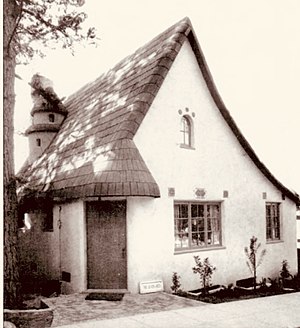Seven Arts Shop
| Seven Arts Shop | |
|---|---|
 Seven Arts Shop street view | |
| Location | Ocean Avenue, Carmel-by-the-Sea, California |
| Coordinates | 36°33′17″N 121°55′26″W / 36.55472°N 121.92389°WCoordinates: 36°33′17″N 121°55′26″W / 36.55472°N 121.92389°W |
| Built | 1923 |
| Built by | Michael J. Murphy |
| Built for | Helena Conger and Herbert Heron |
| Original use | Book and art store |
| Current use | Retail store |
| Architect | Edward G. Kuster |
| Architectural style(s) | Tudor Revival |
The Seven Arts Shop, is a one-story, wood-frame Tudor Storybook retail shop in Carmel-by-the-Sea, California. It has been designated as a significant commercial building in the city's Downtown Historic District Property Survey, and was recorded with the Department of Parks and Recreation on January 23, 2002.[1] The building is occupied in 2022 by the beauty supply company Body Frenzy.
History
The Seven Arts Shop is a one-story, cement stucco, wood-frame Tudor Revival Storybook retail shop. It has a steep pitched side-gabled roof, circular turrets, a chimney, colorful tiles placed in the stucco above the windows, and a front Dutch door. The building is in front of the Court of the Golden Bough on Ocean Avenue and Monte Verde Street, and next to the Carmel Weavers Studio, also known as Cottage of Sweets. It was designed by theatrical producer Edward G. Kuster. Kuster's design is based on inspiration from illustrations of Swedish folk tales of Edmund Dulac. He commissioned Michael J. Murphy to build in September 1923.[1][2]
Originally, the shop was constructed as "The Seven Arts" book and art store for Helena Conger and Herbert Heron. Ads appeared for books, artwork, typewriters, ornamental iron works and lamp fixtures were produced by the Santa Cruz artist, “Otar the Lampmaker."[3] In September 1925, The Seven Arts store moved to the Seven Arts Building on Ocean Avenue and Lincoln Street.[4] The Seven Arts Shop on Ocean Avenue and Monte Verde Street became a Christian Science Reading room in 1936, and Robert Talbot Ties in 1987.[1][5]
Heron commissioned shops and offices around the courtyard. The businesses were associated with the "Seven Arts," which included: music, dancing, literature, painting, sculpture, and architecture. The Seven Arts Shop was Heron's bookshop and printing press, the Seven Arts Press, and The Carmelite (1928-1932) newspaper, which published about art, music, and culture.[6]
The building qualifies for inclusion in the Downtown Historic District Property Survey because it is one of the early commercial "Old Europe" shops in the Golden Bough Court, designed and funded by theatrical producer and lawyer Edward G. Kuster, and built to compliment the Theatre of the Golden Bough. It continues to contribute to the character of the downtown historic district.[1]
Carmel writer Daisy Bostick noted in an April 4, 1924 article for the Carmel Pine Cone that, "In Carmel-by-the-Sea, on Ocean avenue, there is a group of little shops that might well be transferred to an artist's canvas and labeled, A Bit of Old Europe."[7]

In 1926, Tirey L. Ford wrote a book about Monterey and talked about "A Bit Of Carmel," where he described Carmel's "Main Street," as:
A flavor of Italy is twisted into the wrought-iron sign swinging from the front of the Court of the Golden Bough, about which cluster some of the most interesting and lovely of the Carmel shops...The proprietor of The Seven Arts was a professional actor and stage director...The owner of the shops and theater which form the Court of the Golden Bough was a professional cellist, and formerly business manager of one of the largest symphony orchestras in the West.[8]
See also
References
- ^ a b c d Kent L. Seavey (January 23, 2002). "Department Of Parks And Recreation" (PDF). National Park Service. Retrieved April 5, 2022.
- ^ Seavey, Kent (2007). Carmel, A History in Architecture. Arcadia Pub. Carmel-by-the-Sea, California. p. 74. ISBN 9780738547053. Retrieved 2022-04-04.
- ^ "Certificate Of Partnership Fictitious Name". Carmel Pine Cone. July 7, 1923. p. 7. Retrieved April 5, 2022.
- ^ "Pine Needles". Carmel Pine Cone. September 19, 1925. p. 7. Retrieved April 4, 2022.
- ^ Hale, Sharon Lee (1980). A Tribute to Yesterday: the History of Carmel, Carmel Valley, Big Sur, Point Lobos, Carmelite Monastery, and Los Burros. Valley Publishers. Carmel-by-the-Sea, California. p. 65. ISBN 9780913548738. Retrieved 2022-04-04.
- ^ Dramov, Alissandra (2019). Historic Buildings of Downtown Carmel-by-the-Sea. Arcadia Publishing. Carmel-by-the-Sea, California. pp. 62, 77. ISBN 9781467103039. Retrieved 2022-04-04.
- ^ Daisy F. Bostick (April 4, 1924). "Carmel Boasts of America's Best Equipped Studio Theater". Carmel Pine Cone. Retrieved April 4, 2022.
- ^ Ford, Tirey L. (1926). Dawn and the Dons; the Romance of Monterey. The Bruce Brouch Press. pp. 204–206. Retrieved 2022-04-05.
External links
- CS1: Julian–Gregorian uncertainty
- Articles with short description
- Short description with empty Wikidata description
- Coordinates not on Wikidata
- Commons category link is the pagename
- AC with 0 elements
- 1923 establishments in California
- Carmel-by-the-Sea, California
- Buildings and structures in Monterey County, California


